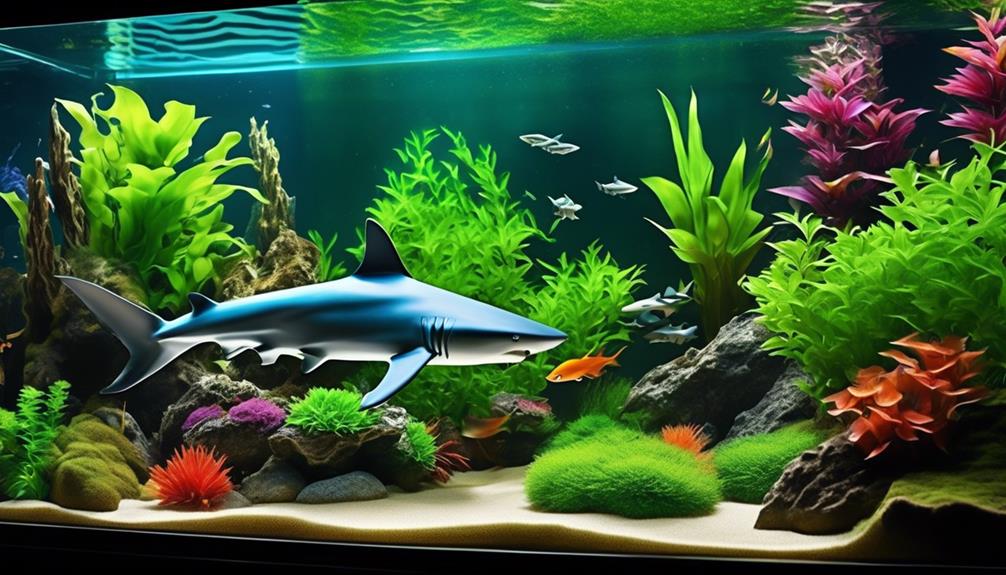Looking to add a touch of awe-inspiring beauty to your aquarium? The Iridescent Shark is the perfect choice for you! Prepare to be amazed as we uncover the secrets of this extraordinary species.
From its mesmerizing appearance to its unique characteristics, this fish is truly a sight to behold. But there’s more to discover than meets the eye.
So, are you ready to dive into the captivating world of the Iridescent Shark? Get ready to unravel the mysteries and unlock the secrets of this magnificent creature.
Habitat and Distribution of Iridescent Shark
The Iridescent Shark, scientifically known as Pangasianodon hypophthalmus, is a large catfish species that’s native to the Mekong basin, Chao Phraya River, and Maeklong basin in Thailand, Myanmar, Laos, and Vietnam. As juveniles, they can be found in schools in the rapids of major Asian rivers, but they become loners as adults. They’ve a diverse diet, feeding on fish, shrimp, crustaceans, insect larvae, fruit, and vegetable matter. The Iridescent Shark is commonly available in the aquarium trade and is also a food staple in Southeast Asian countries.
This catfish species has a body shape that resembles a marine shark. It has a laterally compressed body with two pairs of barbels. Juveniles of the Iridescent Shark exhibit iridescence and two dark vertical bands. When fully grown, they can reach a maximum size of 4 feet (130 cm) and weigh up to 97 lbs (44.0 kg).
While considered hardy, the Iridescent Shark isn’t suitable for home aquariums due to its adult size. It requires a minimum tank size of 300 gallons or larger. They’re peaceful, but can only be kept with fish that they can’t swallow. The Iridescent Shark isn’t picky about water chemistry, but clean water is important for their well-being.
Juveniles can initially be started in a 100-gallon aquarium, but they eventually reach about 39 inches (100 cm) in captivity. They’re very active fish that need a lot of room to swim and thrive better when kept in small groups of about 5 fish.
Description and Size of Iridescent Shark
With its distinctive body shape resembling that of a marine shark, the Iridescent Shark Pangasianodon hypophthalmus is a large catfish species that captures the attention of fish enthusiasts and scientists alike. This species has a lateral compressed body and two pairs of barbels. In its juvenile stage, it exhibits iridescence and two dark vertical bands. As it matures, the iridescence fades, and it develops a more uniform gray coloration.
The Iridescent Shark can reach a maximum size of 4 feet (130 cm) and weigh up to 97 lbs (44.0 kg).
Due to its large size, the Iridescent Shark isn’t suitable for home aquariums. It requires a minimum tank size of 300 gallons or larger to accommodate its active swimming habits. This species is peaceful but should only be kept with fish that they can’t swallow. Although not picky about water chemistry, clean water is crucial for their well-being.
Juveniles can be started in a 100-gallon aquarium, but they quickly outgrow smaller tanks. It’s recommended to keep them in small groups of about 5 fish to ensure their social needs are met.
Fish Keeping Difficulty and Tank Requirements
To properly care for the Iridescent Shark and provide them with the ideal tank environment, it’s important to understand their fish keeping difficulty and the specific tank requirements they need.
While these fish are considered hardy, they aren’t suitable for home aquariums due to their adult size. The minimum tank size required for an Iridescent Shark is 300 gallons or larger. They’re peaceful fish, but can only be kept with fish that they can’t swallow.
Although they aren’t picky about water chemistry, it’s crucial to maintain clean water for their well-being. Juveniles can be started in a 100-gallon aquarium, but they can reach a size of about 39 inches (100 cm) in captivity. As very active fish, they require a lot of room to swim, and they thrive better when kept in small groups of about 5 fish.
It’s important to note that the Iridescent Shark is a scaleless fish, known as a Naked Catfish, and they can easily get scratched or damaged. They occupy the middle of the aquarium and are constantly on the move, occasionally going to the surface for air. They’ve poor eyesight and can be easily spooked, leading to frantic swimming, so it’s important to avoid tapping on the glass or startling them to prevent injury.
In terms of feeding, the Iridescent Shark is an omnivorous species and will eat anything it can find. They become more vegetarian as they get older and lose their teeth. In the home aquarium, they can be fed live, fresh, flake, and pellet foods. A balanced diet of green and meaty foods is crucial for their health.
While they aren’t picky about water chemistry, they prefer soft, acidic water. Regular water changes of 25% should be done on a weekly basis to keep the water clean. Testing the pH of the water can also be helpful. Adequate filtration is necessary due to their high waste production.
To create an ideal tank environment, the aquarium should resemble their natural river environment, with driftwood and river rocks. It’s also important to have a tight-fitting lid as these fish are known to jump. Large biological filtration is needed to handle their waste production.
Behavior and Care Tips for Iridescent Shark
Understanding the behavior and providing proper care for the Iridescent Shark is essential for ensuring their well-being in the aquarium. Also known as the Naked Catfish, this scaleless species is easily scratched or damaged. They’re known to occupy the middle of the aquarium and are constantly on the move. Occasionally, they may go to the surface for air. It’s important to note that Iridescent Sharks have bad eyesight and can be easily spooked, leading to frantic swimming. To prevent injury, it’s advised to avoid tapping on the glass or startling the fish.
In terms of feeding, the Iridescent Shark Catfish is an omnivorous species that will eat anything it can find. As they get older and lose their teeth, they become more vegetarian. In the home aquarium, they can be fed live, fresh, flake, and pellet foods. A balanced diet of both green and meaty foods is crucial for their health.
In terms of aquarium care and setup, Iridescent Sharks aren’t picky about water chemistry but prefer soft, acidic water. Regular water changes of 25% should be done on a weekly basis to keep the water clean. Testing the pH of the water can be helpful. Adequate filtration is necessary due to their high waste production. The aquarium should resemble their natural river environment, with driftwood and river rocks. It’s also important to have a tight-fitting lid as these fish are known to jump. Large biological filtration is needed to handle their waste production. Providing ample room to swim and grow is essential for their well-being.
Foods and Feeding, Aquarium Care, and Setup for Iridescent Shark
When caring for the Iridescent Shark, it’s important to provide appropriate foods and ensure proper aquarium care and setup.
As an omnivorous species, the Iridescent Shark Catfish will eat anything it can find, but as they get older and lose their teeth, they become more vegetarian. In the home aquarium, they can be fed live, fresh, flake, and pellet foods. It’s crucial to provide a balanced diet of green and meaty foods to maintain their health.
While they aren’t picky about water chemistry, they do prefer soft, acidic water. Regular water changes of 25% should be performed on a weekly basis to keep the water clean and testing the pH can be helpful. Due to their high waste production, adequate filtration is necessary, and a large biological filter should be used.
The Iridescent Shark Catfish requires ample room to swim and grow, so the aquarium should resemble their natural river environment with driftwood and river rocks. It’s important to have a tight-fitting lid as these fish are known to jump.

Erzsebet Frey (Eli Frey) is an ecologist and online entrepreneur with a Master of Science in Ecology from the University of Belgrade. Originally from Serbia, she has lived in Sri Lanka since 2017. Eli has worked internationally in countries like Oman, Brazil, Germany, and Sri Lanka. In 2018, she expanded into SEO and blogging, completing courses from UC Davis and Edinburgh. Eli has founded multiple websites focused on biology, ecology, environmental science, sustainable and simple living, and outdoor activities. She enjoys creating nature and simple living videos on YouTube and participates in speleology, diving, and hiking.

